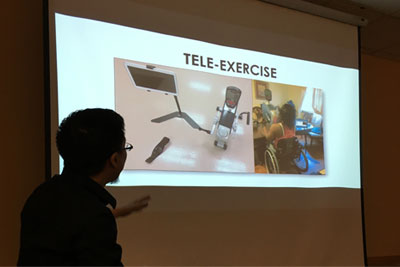According to a recent study by the Centers for Disease Control and Prevention (CDC), 80 percent of Americans do not complete the 150 minutes of moderate exercise per week recommended by the American Heart Association, despite the availability of gyms and other workout facilities. For many of the 270,000 Americans with spinal cord injury (SCI), simply getting to the gym may not even be possible.

Byron Lai, a PhD student in the UAB Department of Physical and Occupational Therapy who also collaborates with the Lakeshore Foundation, explained how tele-exercise eliminates barriers to exercise for individuals with SCI or other disabilities at the Discoveries in the Making event at Hoover Library on March 14, 2016.
The Warm Up
In the United States, there are 12,000 new SCIs each year. Most of the patients are male, with an average age of 41. The most common causes of SCI are motor vehicle accidents, falls, and domestic violence. Following SCI, many individuals have difficulty with recreational activities and household chores compared to before their SCI occurred, leading to inactivity. According to the CDC, inactive adults with disabilities are 50 percent more likely to have at least one chronic disease. Furthermore, these individuals develop secondary conditions such as obesity, depression, or pressure ulcers. Together, these issues make daily activities even more difficult, leading to greater inactivity and rapid physical decline.
Individuals with SCI who wish to maintain an exercise program may not be able to as a result of physical barriers and time constraints. There may be large hills or stairs on the way to the gym, and once inside, the equipment may not be accessible for people with disabilities. These barriers may require so much effort and time that the gym is not an option.
Target Heart Rate Zone
Lai and other investigators at UAB and the Lakeshore Foundation are attempting to use technology to promote exercise in individuals with SCI. Through tele-exercise, Lai has been able to virtually deliver supervised exercise to participants at their homes, on their own time. Participants were given heart rate monitors, tablets, tablet stands, and hand cycles for this program, and they completed personalized exercise sessions with a trainer who received heart rate readings and delivered messages to participants in real time. The goal of each session was moderate exercise, working to reach 60 to 80 percent of a participant’s maximum heart rate, based on the American College of Sports Medicine’s recommendations.

Currently, five individuals with SCI have completed this tele-exercise program. Comparing a session prior to the eight-week program and a session following its completion, participants increased their aerobic capacity, or the ability of the heart and lungs to deliver oxygen to the muscles, by 32 percent. Participants also increased their daily physical activity hours by 70 percent.
Importantly, this program was completed with 97 percent adherence, including both the exercise sessions and the interview following the program. This interview portion helped Lai to better understand participants’ views and perceptions of the program. As one participant explained, “I did it [tele-exercise] more because it’s more convenient and on my time…” Based both on the physical and behavioral advances resulting from this program, Lai believes that tele-exercise is a great way to address barriers to exercise.
Future Exercise Plan
Lai envisions a “Brady Bunch” style of tele-exercise where multiple people can exercise together virtually in the near future. He would also like to see computer stations at gyms to make tele-exercise available to reach more people. Lai and colleagues are currently recruiting participants with SCI and Parkinson’s disease for a similar program to further examine the benefits of tele-exercise.